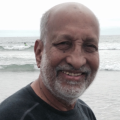Struggle for Bangladesh’s cultural soul
SYLHET, Bangladesh: Is modernity finally putting brakes on the Islamization campaign in Bangladesh? Is it eroding the nation’s ethnic culture? These questions keep haunting me during trips to Bangladesh. A visit yesterday to Shahjalal University of Science and Technology in Sylhet lent the two questions special poignancy.
The population of what is now Bangladesh is nearly 90 percent Muslim. They were in the vanguard of the Pakistan movement. By the 1940s they had been fed up with the economic and cultural suppression by the dominant Hindu elites. They pulsated with the pan-Islamic fervor and joined other Muslim communities in the Indian subcontinent in a campaign to carve out the Muslim state of Pakistan. Ironically, a veteran of the Pakistan movement was Sheikh Mujibur Rahman, who would later lead the struggle to dismember Pakistan to create independent Bangladesh.
In fact Muslims in Bangladesh, which used to be called East Bengal and later East Pakistan, began to feel their Bengali ethnic pull soon after they had helped create Pakistan. Beginning in 1952, just five years after the birth of Pakistan, a movement to make Bengali an official language in Pakistan dramatized that ethnic resurgence. It was fueled by the repression of Bengalis in East Pakistan by non-Bengali political and military elites of West Pakistan. In 1971 that struggle culminated in East Pakistan breaking away from Pakistan’s western provinces.
But then, almost immediately after Bangladeshis severed their ties with their fellow Muslims in (West) Pakistan, their Islamic spirit began to revive again, almost with a vengeance. During several visits to Bangladesh I almost dazed from the sights of mosques and Islamic schools proliferating and prayer congregations overflowing mosques buildings. More and more Bangladeshi Muslim women began covering up their heads in colleges, government offices and market places. More and more Bangladeshi men wore Islamic clothing.
“It’s incredible,” Hamidul Huq Chowdhury, publisher of the Bangladesh Observer newspaper (where I once worked), exclaimed during my 1991 visit to his home in Dhaka, the Bangladeshi capital. He said the Islamic upsurge in post-independence Bangladesh, “is stronger and more widespread” than it was during the Pakistan movement.
Today Bangladeshi society appears to be undergoing a third cultural twist. Islam and modernity seem to be squaring off for the domination of Bangladeshi culture. Jannatul Ferdous Shikha, a demographic researcher I met yesterday at Shahjalal University, said Bangladesh was “Islamizing and modernizing” simultaneously. She didn’t wear a headscarf and expressed strong secularist views. She predicted that “secularism will overcome the backwardness and bigotry” of Bangladeshi Islamists. Shikha praised a “growing secular movement,” which she said was widening and deepening in Bangladesh.
“But it’s true,” said the political scientist, “that people [Bangladeshi Muslims] are acquiring religious habits. They follow whatever the “huzurs” [Muslim clerics] say. I don’t know why.” She said the Muslims showing enthusiasm for Islam don’t read Islamic scripture. “Many of them don’t pray, but are crazy about Islam, whatever they think it is.”
Some of the other professors and students I met on Shahjalal University campus pointed out that Bangladesh had been making notable progress economically and educationally.
During the last four decades the country’s capita GDP increased 10-fold to $2,000, and literacy rate tripled to 66 percent. Significantly, the modernizing trend has defied the equally dramatic increase in political and bureaucratic corruption and the endemic political violence and instability.
A Transparency International survey for a four-year period has found Bangladesh to be the world’s most corrupt country. My refusal to bribe Bangladeshi officials has made me face difficulties in reclaiming some of my farmlands and shares in fisheries from usurpers. I have learned from several reliable sources that magistrates in this Bangladeshi town take bribes for favorable judgments in criminal cases.
Yet I have been impressed by sights of the rapid improvements in Bangladesh’s roads and highways, and the mushrooming of schools, colleges, businesses and industries. Shaheena Sultana, assistant registrar at the university, said the economic progress and modernization was a “bigger story” than Islamization.
The physical and social spectacles in Bangladesh are sparkling with symbols of modernity and globalization. Roads and streets – once shared by bicycles, bullock carts, goats and cows and occasional passenger buses – are now often clogged by cars, trucks, and streams of buses. Cell phones, including smartphones, are used almost universally throughout the country. An ever-growing number of Bangladeshis wear blue jeans and slacks, dropping the native male skirt called “lungi.” Most urban dwellers can speak English or understand necessary English terms.
In fact English is replacing Bengali in the business and industrial culture of Bangladesh. On my way to Shahjalal University, I could hardly see an all-Bengali store sign. Those signs bore wholly or partly English names, usually written in the Bengali script: Holy City Grammar School and College, Modern Hair Dressers, Shourobh [Bengali word for fragrance] Stationery Store, Shopto Dinga [seven-canoe] Foreign Furniture, Derai [name of a place] Bedding House, Baraka [Arabic word for blessing] Arabic Learning Center, Messrs Ilyas [man’s name] and Sons, and so on.
On some of those signs, the English script is appended to the Bengali one.
What a paradigm shift! Who could have imagined during the Bengali language movement in East Pakistan in the 1950s that Bengali Muslims would one day trade their cherished native language and concepts for foreign ones?
The twin movements of Islamization and modernization, which are at loggerheads themselves, are clearly corroding Bengali ethnic values and cultural idiom in Bangladesh. I’m wondering whether Islam or modernity is going to be the final winner.
Or modernized Islam?
- Mustafa Malik, who hosts the blog ‘Beyond Freedom,’ is traveling in Bangladesh and India.
